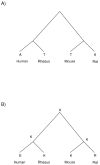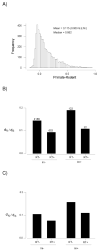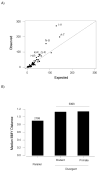More radical amino acid replacements in primates than in rodents: support for the evolutionary role of effective population size
- PMID: 19332110
- PMCID: PMC2706701
- DOI: 10.1016/j.gene.2009.03.012
More radical amino acid replacements in primates than in rodents: support for the evolutionary role of effective population size
Abstract
We examined the pattern of nucleotide substitution in 4933 conserved single-copy orthologous protein-coding genes of human, rhesus, mouse, and rat. Consistent with previous studies, the median ratio of the number of nonsynonymous substitutions per nonsynonymous site (d(N)) to the number of synonymous substitutions per synonymous site (d(S)) was significantly higher in the comparison between the two primates than in the comparison between the two rodents. This pattern was particularly strong in the case of genes expressed in the immune system, but also occurred in other genes, including a set of highly conserved genes involved in the regulation of transcription. Both synonymous and nonsynonymous differences occurred independently in the same codons in the primates and in the rodents to a greater extent than expected by chance, but the extent of the deviation from random expectation was much greater in the case of nonsynonymous differences. Parallel amino acid replacements occurred at the same sites in the primates and rodents far more frequently than expected by chance, but tended to involve very conservative amino acid changes. Divergent amino acid changes involved more chemically different amino acids than parallel changes, and divergent amino acid replacements between the primates were significantly more radical than those between the rodents. These results are most easily explained on the hypothesis that the evolution of these genes has been shaped largely by purifying selection, which has been less effective in primates than in rodents, presumably as a consequence of lower long-term effective population sizes in the former.
Figures




References
-
- Barraclough TG, Fontaneto D, Ricci C, Hernious EA. Evidence for inefficient selection against deleterious mutations in cytochrome oxidase I of asexual bdelloid rotifers. Mol Biol Evol. 2007;24:1952–1962. - PubMed
-
- Bejerano G, Pheasant M, Makunin I, Stephen S, Kent WJ, Mattick JS, Haussler D. Ultraconserved elements in the human genome. Science. 2004;304:1321–1325. - PubMed
-
- Berlin S, Ellegren H. Fast accumulation of nonsynonymous mutations on the female-specific W chromosome in birds. J Mol Evol. 2006;62:66–72. - PubMed
Publication types
MeSH terms
Grants and funding
LinkOut - more resources
Full Text Sources

